After tallying up a record number of visitors, more than 9,000 over five days, Norway’s 28th Riddu Riddu Indigenous festival wrapped up in the early hours of this past Sunday.
“The festival has surpassed my wildest fantasies,” said festival manager Sandra Márjá West in a release.

The outdoor stage at Riddu Riddu 2019, which this year saw a record number coming to the festival in northern Norway. (Photo courtesy of Riddu Riddu)
“I am happy that so many people would go to Riddu Riđđu this year,” West said.
I wasn’t at Riddu Riddu to watch the festival unfold, but sitting 5,200 kilometres away at my at off-grid island cabin: I had made no plans for July other than to watch the eagles roosting and see my family.
But then suddenly, thanks to social media, accessible now on my phone, it felt as if Riddu Riddu was taking place close by, and I wished I could just step off my boat and be there.
Riddu Riddu, which takes place annually in Kåfjord in Arctic Norway, includes Indigenous music, art, theatre and dance, youth camps with artistic and political workshops, a children’s festival, seminars, course programs, films and literature.
Riddu Riddu means stormy wind off the water in the Saami language, and had I been at the festival I would have dressed warmly as I could see that my Saami friends wore light parkas over their gáktis during the evenings.
Every year, Riddu Riddu reaches out to other circumpolar regions and indigenous peoples to spotlight the music, art and culture from a northern, Indigenous people.
And this year, its featured Indigenous northern people of the year were the Inuit of Nunavut.

Silla and Rise, who fuse Inuit throat singing with dance floor beats, perform at Riddu Riddu. (Photo by Kalvig Anderson/courtesy of Riddu Riddu)
The line up of performers from Nunavut included, among others, award-winning Tanya Tagaq and Silla and Rise.

Tanya Tagaq, winner of numerous awards, performs July 12 at Riddu Riddu. (Photo by Kalvig Anderson/courtesy of Riddu Riddu)
Tagaq, who has appeared at Riddu Riddu several times, also read to festival-goers from her new book, Split Tooth, which I reviewed for Nunatsiaq News.
Back in 2004, Riddu Riddu’s Indigenous people of the year were the Inuit of Nunavik.
They came after, in 2003, I had first gone to Riddu Riddu with two throat singers from Nunavik, who performed under the name of Puppuq.
After that festival, I had headed south into Finland with a busload of Koryaks, members of Mengo, a 21-member dance and theatre troupe from Kamchatka in Russia’s Far East.
The Koryaks, 6,600 of whom live in Kamchatka, were Riddu Riddu’s northern people of 2003, arriving at the festival with boiled reindeer meat, broiled salmon and fish cakes.
I can’t remember how we communicated about where they should let me off, but their bus left south of Oulu where I spent a week with friends at their island cottage, immersing myself again in Finnish.
In 2006, I was back at Riddu Riddu, when the program showcased everything from polar ska, Ainu dub, tribal funk to ethno-futuristic rock played by groups from Norway, Russia, Japan, Brazil, Siberia, South Africa, Greenland and Alaska. I hardly slept.

Oki plays the tonkori, an Ainu stringed instrument, mixing traditional Ainu music with reggae, dub and other styles of world music. (Photo by Jane George)
I stood in front of the Riddu Riddu stage late into the night, listening to Oki, an Ainu from Japan.

Members of the Siberian group Ayarhaan, as seen at Riddu Riddu in 2006. (Photo by Jane George)
And then there was the Siberian group Ayarhaan, which means “the tribe of the creator” which took the festival by surprise with its wildly traditional music combining elements of traditional throat-singing and Jimmy Hendrix.
Their home, Yakutia in central Siberia, is a place where temperatures range from -40 C in winter to 30 C in the summer, an extreme sort of place that produces an extreme version of throat singing.
“To survive you have to be strong, so you can hear the strength in the music,” Albina Degtyareva, the group’s lead singer, told me. “In Yakutia, you can feel and hear the power inside you.”
Her mouth harp, or “khomous,” looked like a pair of scissors with a metal tine sticking through the middle. Yakutians traditionally used the khomous, which was said to have been made by gods and possess a magical voice, to accompany their throat-singing. But Degtyareva said that 20 years ago, only 10 people in Yakutia knew how to use the khomous.
Raised in a small village, with a family where the harp was still played, she said she was one of only two people in Yakutia who felt confident enough to teach others how to play.
(And playing the khomous certainly isn’t easy: you have to learn how to make the separate oo-aa-ay-e sounds and then vary them by using your tongue. At the same time, your hand has to stroke the harp in a certain way, moving it back and forward, “like dancing,” slowly or fast, depending on the desired sound. It’s the kind of music someone has to teach you personally — and that’s what Degtyareva and her two partners did in workshops at Riddu Riddu, showing an interested group how to produce basic sounds on the khomous.)
For me, going to Riddu Riddu was an inspiration and an affirmation of strength and cultural and linguistic unity which I had always felt throughout the Arctic—and so it seemed this year for some of those at Riddu Riddu.
To see more photos from Riddu Riddu look at their Facebook page.
And, if you haven’t already, take a look at my “Like an iceberg” series of posts on being a journalist in the Arctic in the 1990s.